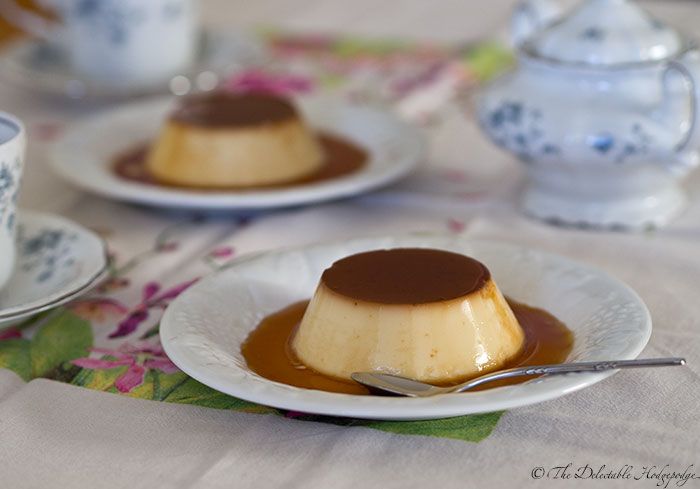
Crème Caramel
| Ingredient | 6 7-oz. Dishes | 6 200ml Dishes |
|---|---|---|
| Caramel Sauce | ||
| sugar | ½ cup + 1 Tbsp. | 120g |
| water | 2 Tbsp. | 2 Tbsp. |
| hot water | 2½ Tbsp. | 2½ Tbsp. |
| Custard | ||
| whole egg | 3 | 3 |
| egg yolk | 6 | 6 |
| milk | 3⅛ cups | 750 ml |
| sugar | 3 Tbsp. + ½ cup | 40g + 100g |
| vanilla extract | 1 tsp. | 1 tsp. |
Depending on where you’re from, a version of this creamy custard pudding and liquid caramel dessert can be called crème caramel, flan, caramel custard, or, in Japan where it is extremely popular, custard pudding or simply “purin”. This particular recipe has a silky, delicate custard contrasted with dark, slightly bitter caramel sauce, producing this refined juxtaposition of flavors out of the simplest ingredients.
Preparation
- Let eggs come to room temperature.
- Heat a kettle of water to almost boiling to use for the water bath.
Directions
- Prepare caramel sauce.
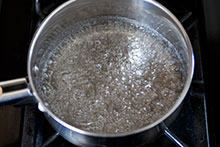 Combine 2 Tbsp. of water and the sugar in a small saucepan over medium heat. Heat, shaking the pan occasionally; do not stir.
Combine 2 Tbsp. of water and the sugar in a small saucepan over medium heat. Heat, shaking the pan occasionally; do not stir.- As the sugar boils, it will darken; when it reaches a relatively dark brown, remove from heat.
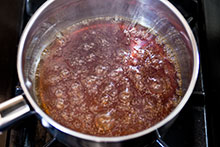
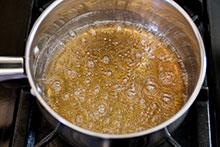
- Immediately add two and a half tablespoons of hot water to the hot caramel and shake the pan to mix. The water will boil violently when added, so be careful not to get burned by the steam or spattering caramel; you may want to use the lid of the pan as a shield and immediately cover with it for safety.
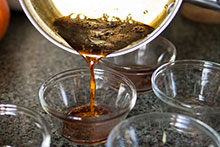 When the boiling has settled down, you should have a thin, dark caramel liquid; while it is still hot, divide the sauce between six oven-safe ramekins or other about 7 oz. (200 ml) baking dishes.
When the boiling has settled down, you should have a thin, dark caramel liquid; while it is still hot, divide the sauce between six oven-safe ramekins or other about 7 oz. (200 ml) baking dishes.- Begin preheating the oven to 325°F or 350°F (160 or 180°C).
- Prepare custard.
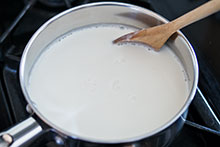 In a medium saucepan combine 2 cups (500 ml) of milk and 3 Tbsp. (40g) of sugar. Heat over medium, stirring with a wooden spoon, until the sugar dissolves. Remove from heat and add the remaining cup and an eighth (250 ml) of milk.
In a medium saucepan combine 2 cups (500 ml) of milk and 3 Tbsp. (40g) of sugar. Heat over medium, stirring with a wooden spoon, until the sugar dissolves. Remove from heat and add the remaining cup and an eighth (250 ml) of milk.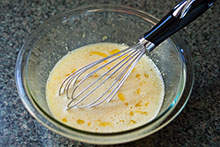 In a medium mixing bowl, briefly scramble the whole eggs and egg yolks. Add the remaining half cup (100g) of sugar and mix with a whisk, being careful not to make too much foam.
In a medium mixing bowl, briefly scramble the whole eggs and egg yolks. Add the remaining half cup (100g) of sugar and mix with a whisk, being careful not to make too much foam.- While the milk in the pan is still warm, add it to the egg mixture slowly, stirring constantly with a whisk but being careful not to make too much foam.
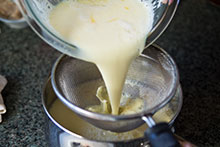 Strain the mixture through a wire mesh strainer back into the pan (or another bowl), to remove any clumps of egg. Stir in vanilla extract.
Strain the mixture through a wire mesh strainer back into the pan (or another bowl), to remove any clumps of egg. Stir in vanilla extract.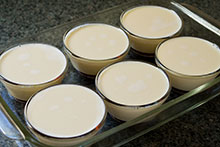 Place the six baking dishes with caramel sauce into a baking pan you will use for a water bath when baking them. Divide the custard mixture equally among the six dishes, pouring it gently so it doesn’t kick up any foam.
Place the six baking dishes with caramel sauce into a baking pan you will use for a water bath when baking them. Divide the custard mixture equally among the six dishes, pouring it gently so it doesn’t kick up any foam.
- Steam bake.
- Pour enough hot water into the large baking dish to cover about two thirds of the height of the individual baking cups. The water should be around 160°F (70°C).
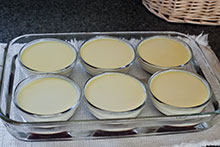 Cover the large baking dish loosely with a sheet of aluminum foil and bake in a 325 or 350°F (160 or 180°C) oven for 50-60 minutes. Depending on your oven, you may want to rotate the pan halfway through. A toothpick or cake tester inserted in the middle of the custard should come out clean when they are done.
Cover the large baking dish loosely with a sheet of aluminum foil and bake in a 325 or 350°F (160 or 180°C) oven for 50-60 minutes. Depending on your oven, you may want to rotate the pan halfway through. A toothpick or cake tester inserted in the middle of the custard should come out clean when they are done.- Let the custards cool for a while before covering and transferring to the refrigerator to chill. Serve chilled either in the individual dishes or turned out, caramel side up, onto a plate.
Notes
- The darker you let the caramel get before adding the water, the more bitterness it will have. Be careful not to let it get too dark or it will burn or be too bitter, but if it’s too light the caramel will just be sweet, and won’t have much character; trying it a few times is the best way to get a sense of how dark you like it.
- If you’re using glass baking dishes or ramekins, the heat transfers more slowly than if the baking cups are metal, and the temperature of the water also effects the baking time, so the baking time can vary quite a bit. If you are using a metal baking dish for the water bath, you might want to put a small towel in the bottom of the pan underneath the cups, to slow the transfer of heat from the bottom of the pan to the cups.
- If the temperature of the oven is too high, or if you overcook the custards, small pockmarks will form on the outside surface and the smooth texture will suffer.
- If you’re serving the puddings on a plate, you will need to run a thin cake tester around the outside edge to break the seal with the baking dish to be able to get it to turn out. The caramel turns into a very thin liquid during baking, so be sure to use a dish that will keep it contained.
- Science note: Adding some sugar to the milk while heating it initially makes it more difficult for the protein to bond together and form a skin on top. Adding the sugar to the eggs before mixing uses the same effect to break up the globs of egg protein, making them mix more readily.
